 “Writing the truth being obviously so difficult, I have in the interests of it allowed myself to go sometimes slightly beyond and slightly this side of it. All events and persons in this book are accidental and have something to do with the truth.” — Robert Capa, front jacket flap, Slightly Out of Focus, first edition (1947)
“Writing the truth being obviously so difficult, I have in the interests of it allowed myself to go sometimes slightly beyond and slightly this side of it. All events and persons in this book are accidental and have something to do with the truth.” — Robert Capa, front jacket flap, Slightly Out of Focus, first edition (1947)
•
What pictures, existing and merely reported by the photographer and others, did Robert Capa make at Omaha Beach on June 6, 1944, and what do they have to tell us?
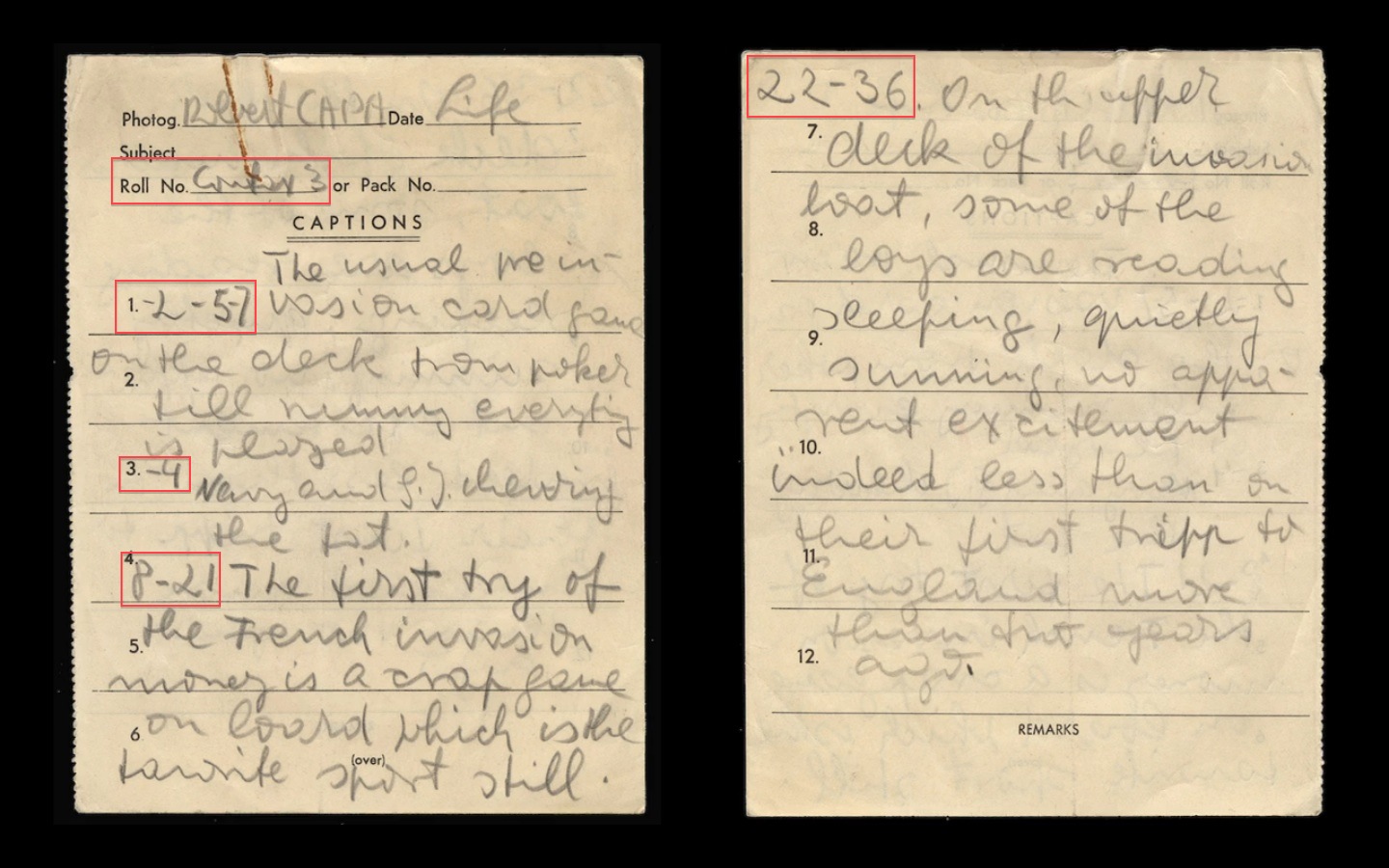
Robert Capa, D-Day image captions, Contax 35mm Roll 3.
From the caption notes he sent to John Morris in London with his films when he returned from Normandy, the subject of my previous post, we know that three of the four 35mm rolls he sent he’d actually made on shipboard the night before the landing. That leaves only one roll of images from the landing itself. I’ll call that Roll 4, and the camera with which Capa made those exposures Contax A. (To see all of Capa’s D-Day images at the Magnum website, click here.)
Here’s the entirety of what Capa wrote in his 1947 memoir of World War II, Slightly Out of Focus, regarding his actual photographing on Omaha Beach that morning:
“The U.S.S. Chase was a mother ship which carried many assault barges which it would release ten miles off the French coast. I would have to make up my mind and choose a barge to ride in … Colonel Taylor, commander of the 16th Infantry Regiment, of the 1st Division, tipped me off that regimental headquarters would follow close behind the first wave of infantry. This sounded like the real favorite — an even-money bet — two to one to be alive in the evening. … I am a gambler. I decided to go in with company E in the first wave. Once I decided to go in with the first assault troops I began to convince myself that the invasion would be a pushover … “
“The coast of Normandy was still miles away when the first unmistakable popping reached our listening ears. We ducked down in the puky water in the bottom of the barge and ceased to watch the approaching coastline. … It was now light enough to start taking pictures, and I brought my first Contax camera [Contax A, loaded with Roll 4] out of its waterproof oilskin. The flat bottom of our barge hit the earth of France. The boatswain lowered the steel-covered barge front, and there, between the grotesque designs of steel obstacles sticking out of the water, was a thin line of land covered with smoke — our Europe, the ‘Easy Red’ beach.
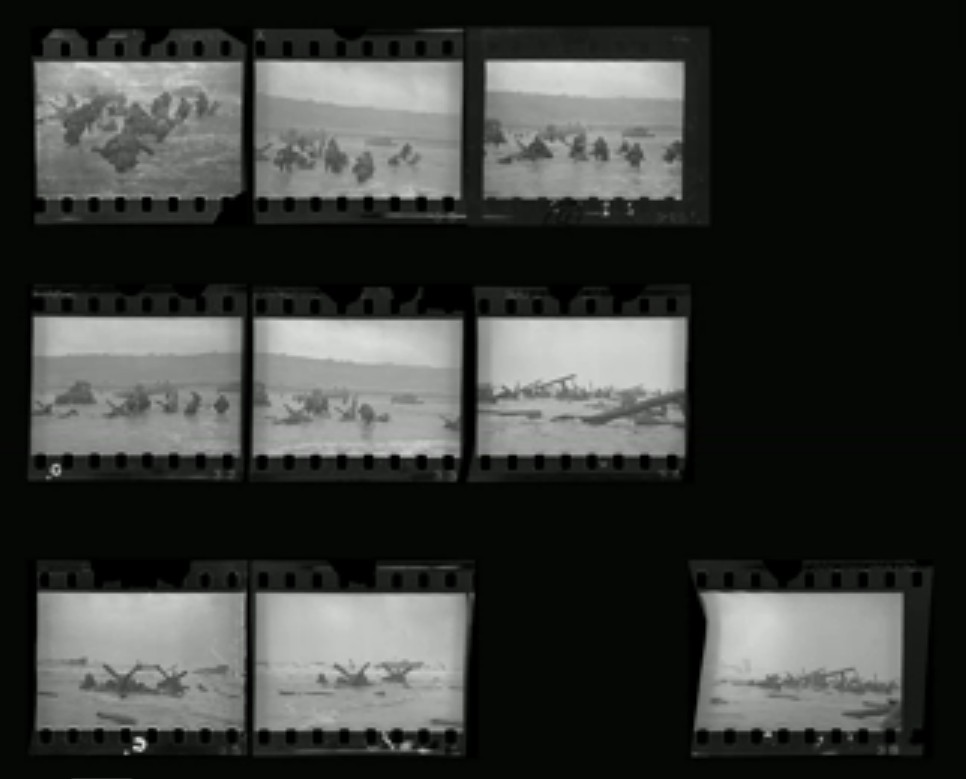
Robert Capa, D-Day frames from 6 June 1944. Courtesy Wikimedia Commons.
“… The men from my barge waded in the water. Waist-deep, with rifles ready to shoot, with the invasion obstacles and the smoking beach in the background — this was good enough for the photographer. I paused for a moment on the gangplank to take my first real picture of the invasion. [Roll 4, image 1, frame 29, above. Images 2-5, frames 30-33, indicate that he stayed on the LCI for four more exposures, this 30-second delay making the boat a sitting target.] The boatswain, who was in an understandable hurry to get the hell out of there, mistook my picture-taking attitude for explicable hesitation, and helped me make up my mind with a well-aimed kick in the rear. The water was cold, and the beach still more than a hundred yards away. The bullets tore holes in the water around me, and I made for the nearest steel obstacle. A soldier got there at the same time, and for a few minutes we shared its cover. … The sound of his rifle gave him enough courage to move forward and he left the obstacle to me. It was a foot larger now, and I felt safe enough to take pictures of the other guys hiding just like I was. [Roll 4, image 6, frame 34, above.]
“It was still very early and very gray for good pictures, but the gray water and the gray sky made the little men, dodging under the surrealistic designs of Hitler’s anti-invasion brain trust, very effective.
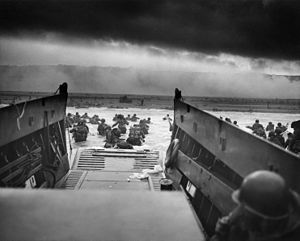
“Into the Jaws of Death,” photo by Chief Photographer’s Mate Robert F. Sargent. Assault craft land one of the first waves at Omaha Beach, Company E, 16th Infantry, 1st Infantry Division. Courtesy National Archives and Records Administration.
“I finished my pictures, and the sea was cold in my trousers. Reluctantly, I tried to move away from my steel pole, but the bullets chased me back every time. Fifty yards ahead of me, one of our half-burnt amphibious tanks stuck out of the water and offered me my next cover. Between floating bodies I reached it, paused for a few more pictures, and gathered my guts for the last jump to the beach. [Roll 4, images 7-9, frames 35-36, 38 above, and also the missing negative of the image of Riley, frame 37.]
“… Exhausted from the water and the fear, we lay flat on a small strip of wet sand between the sea and the barbed wire. I crawled on my stomach over to my friend Larry, the Irish padre of the regiment, who could swear better than any amateur. … Thus comforted by religion, I took out my second Contax camera and began to shoot without raising my head.
I’ll call this second camera Contax B, loaded with what I’ll designate as Roll 5. Problem: if it ever existed in the first place, this roll of film vanished into thin air.
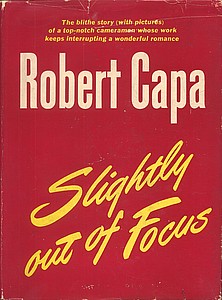
Robert Capa, “Slightly Out of Focus” (1947), cover.
“From the air, ‘Easy Red’ must have looked like an open tin of sardines. Shooting from the sardine’s angle, the foreground of my pictures was filled with wet boots and green faces. Above the boots and faces, my picture frames were filled with shrapnel smoke; burnt tanks and sinking barges formed my background. … [More images supposedly made with Contax B on the mysteriously disappeared Roll 5.]
“The Irish priest and the Jewish doctor were the first to stand up on the ‘Easy Red’ beach. I shot the picture. The next shell fell even closer. I didn’t dare to take my eyes off the finder of my Contax [Contax B] and frantically shot frame after frame. [Yet more images supposedly made with Contax B on the mysteriously disappeared Roll 5.] Half a minute later, my camera jammed — my roll was finished. [Roll 5.] I reached in my bag for a new roll, and my wet, shaking hands ruined the roll before I could insert it in my camera.” [Let’s call the wet, ruined, unexposed roll Roll 6.]
Clearly, for those now-vanished exposures Capa used the camera I’ve called Contax B, loaded first with the film I’ve called Roll 5. Capa then attempted to reload Contax B with Roll 6 but water-damaged it somehow. Or so he says. This assumes that Capa speaks truthfully here about using his second Contax. Since he sent no Roll 5 to Morris, I don’t believe a word of it.
The Fog of War
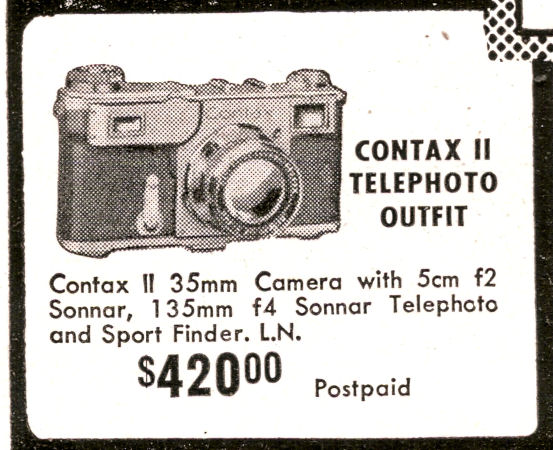
Peerless Camera Store, Contax II ad, ca. 1940.
Sam Fuller, whom Capa had photographed the day before on shipboard, came in on a landing boat after Capa’s, and in his 2002 memoir A Third Face recalls seeing him take out a telephoto lens to photograph a German officer silhouetted on the hill above. (Fuller would become a Hollywood film director and make a movie about that day, The Big Red One. As an odd historical coincidence, Sam Wagstaff, then a Navy ensign, served off the coast of Normandy during the D-Day invasion of Omaha Beach.)
Fuller is almost certainly self-mythologizing here, like Steve Martin inventing a special moment with Diane Arbus. If Fuller’s tale is more than fanciful, Capa would have swapped that telephoto for the 50mm lens on Contax B (with his “wet, shaking hands”), and those images would have been on the hypothetical Roll 5. And he’d have had to use a telephoto lens that, given the distance from the very edge of the surf to the edge of the cliff, would have been inadequate to the task described.
•
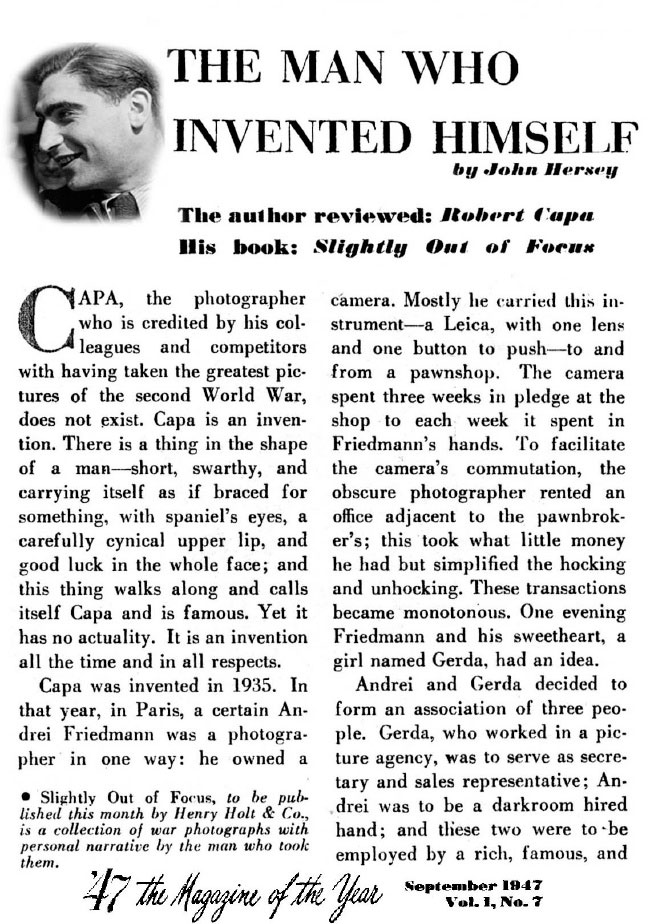
John Hersey, “The Man Who Invented Himself,” review of Capa’s memoir, ’47 magazine, 1947.
Here things get hopelessly muddled. If we’re to believe Capa, he switches back to Contax A, still loaded with Roll 4, on which he’s made 10 exposures so far, to make the lone iconic image of the wounded Huston Riley, crawling to shore, just before Capa and a sergeant supposedly drag him to relative safety in their hiding place. But Capa doesn’t mention saving Private Riley, who’d also come in with the first wave, or making that image of him before doing so. In the event, this appears as the last successful exposure on Roll 4, made with Contax A.
According to Riley’s account, it took him about 30 minutes to make his way to the beach. Whether his LCI preceded or followed Capa’s we can’t determine. In “The Man Behind the ‘Face’ Remembers D-Day,”a short 60th D-Day anniversary memoir he wrote for the journal World War II (June 2004, Vol. 19, Issue 3, p. 40), Riley recalls,
“The tide was almost in when I reached the beach. Since I was very wet, it was a real struggle to try to get up and run. I ran in a half crouch, but I was hit in the shoulder close to the neck with a burst of automatic weapons fire. Two fellows grabbed me by the arms and pulled me to the base of a bluff. One was a buck sergeant from E Company and the other was a photographer with a camera around his neck and a press insignia on his shoulder. All I could think of was, ‘What in the hell is this guy doing here?’ Then he ran off into the water into a landing craft.”
But this can’t be right. If that’s Riley in the photo, he’s still in the water, at least two feet deep above the sandy bottom, somewhere near the disabled Armored Vehicle 10 visible on the left-hand side of the early negatives. Capa and his friends are laying low just past the waterline at the edge of the beach. The closest thing to a “bluff” is hundreds of yards away. Perhaps we should chalk this up to the shock of the situation and his new wounds. If the timing’s accurate, then from the moment the door of his landing craft opened to the making of his image of Riley Capa had spent somewhere around 30 minutes on Omaha Beach, perhaps only half that much time, almost certainly not more, when Riley saw him sprint to the LCI.
“I paused for a moment,” Capa continues, “… and then I had it bad. The empty camera trembled in my hands.” Is this Contax A or Contax B? In my opinion, Contax B never got used; this is Contax A, from which he’s just unloaded Roll 4. Regardless, that concluded Capa’s photographing on the beach itself:
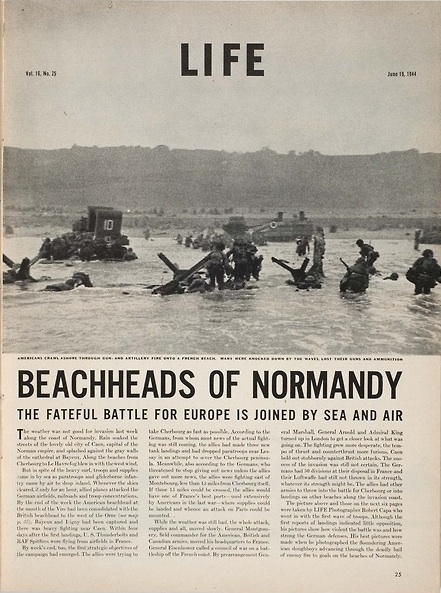
“Beachheads of Normandy,” LIFE magazine feature on D-Day with Robert Capa photos, June 19, 1944.
“It was a new kind of fear, shaking my body from toe to hair, and twisting my face. … An LCI [landing craft, infantry] braved the fire … I did not think and I didn’t decide it. I just stood up and ran toward the boat. … I held my cameras high above my head, and suddenly I knew I was running away. … [I] told myself, ‘I am just going to dry my hands on that boat.’
“… Our boat was listing and we slowly pulled away from the beach to try and reach the mother ship before we sank. I went down to the engine room, dried my hands, and put fresh films in both cameras. [I’ll call those Rolls 7 and 8, freshly loaded into Contaxes A and B. Neither of those rolls got to London.] I got up on deck again in time to take one last picture of the smoke-covered beach. Then I took some shots of the crew giving transfusions on the open deck. An invasion barge came alongside and took us off the sinking boat. The transfer of the badly wounded in the heavy seas was a difficult business. I took no more pictures, I was busy lifting stretchers. The barge brought us to the U.S.S. Chase, the very boat I had left only six hours before. On the Chase, the last wave of the 16th Infantry was just being lowered …
This was my last chance to return to the beach. I did not go. … I started taking pictures [of the scene aboard the Chase.] Then things got confused. …”
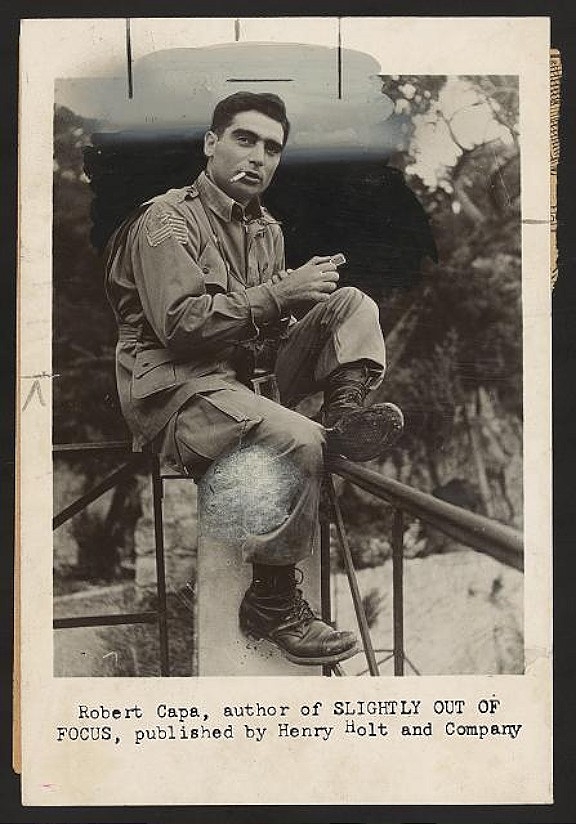
Robert Capa, publicity photo for “Slightly Out of Focus,” 1947.
By his own account, he’d actually left the U.S.S. Chase around 4 a.m. Four hours later, at 8 a.m., Capa found himself aboard it once again, the Chase now serving as a hospital evacuation ship transporting wounded soldiers back across the English Channel to Portsmouth.
At 1:30 p.m. that day the last German gun fell silent, the last German defenders surrendered, and the battle of Omaha Beach, a turning point in the war, ended. Capa, “the greatest war photographer in the world,” who’d volunteered to witness it from the beginning, had missed most of it.
•
So, to sum up, Capa’s retrospective account of his short time on Omaha Beach, written three years later and excerpted above, confesses his terror and his driving need to escape the charnel house he saw there. That’s to his credit. But he also tries retroactively to pad out his skimpy 11 images from Roll 4 with a full 36 exposures from a fictional Roll 5, plus one image of the smoke-filled beach made from the landing craft before he makes his getaway. He needs that to make more credible his now-formal claim that LIFE’s London darkroom destroyed his other 95 images. But there was no Roll 5; there were no other images. What we see in the “Magnificent Eleven” is what he got — all of it.
(For an index of links to all posts in this series, click here.)
•
John Morris will participate in a conversation with Robert Pledge, founder and director of Contact Press Images, at the International Center of Photography on June 24, 2014. They’ll stream it, so you can watch it live online at www.icp.org/live. Clicking on that link will enable you to submit a question in advance.
Alternate History: Robert Capa on D-Day (5)
•
What pictures, existing and merely reported by the photographer and others, did Robert Capa make at Omaha Beach on June 6, 1944, and what do they have to tell us?
Robert Capa, D-Day image captions, Contax 35mm Roll 3.
From the caption notes he sent to John Morris in London with his films when he returned from Normandy, the subject of my previous post, we know that three of the four 35mm rolls he sent he’d actually made on shipboard the night before the landing. That leaves only one roll of images from the landing itself. I’ll call that Roll 4, and the camera with which Capa made those exposures Contax A. (To see all of Capa’s D-Day images at the Magnum website, click here.)
Here’s the entirety of what Capa wrote in his 1947 memoir of World War II, Slightly Out of Focus, regarding his actual photographing on Omaha Beach that morning:
“The U.S.S. Chase was a mother ship which carried many assault barges which it would release ten miles off the French coast. I would have to make up my mind and choose a barge to ride in … Colonel Taylor, commander of the 16th Infantry Regiment, of the 1st Division, tipped me off that regimental headquarters would follow close behind the first wave of infantry. This sounded like the real favorite — an even-money bet — two to one to be alive in the evening. … I am a gambler. I decided to go in with company E in the first wave. Once I decided to go in with the first assault troops I began to convince myself that the invasion would be a pushover … “
“The coast of Normandy was still miles away when the first unmistakable popping reached our listening ears. We ducked down in the puky water in the bottom of the barge and ceased to watch the approaching coastline. … It was now light enough to start taking pictures, and I brought my first Contax camera [Contax A, loaded with Roll 4] out of its waterproof oilskin. The flat bottom of our barge hit the earth of France. The boatswain lowered the steel-covered barge front, and there, between the grotesque designs of steel obstacles sticking out of the water, was a thin line of land covered with smoke — our Europe, the ‘Easy Red’ beach.
Robert Capa, D-Day frames from 6 June 1944. Courtesy Wikimedia Commons.
“… The men from my barge waded in the water. Waist-deep, with rifles ready to shoot, with the invasion obstacles and the smoking beach in the background — this was good enough for the photographer. I paused for a moment on the gangplank to take my first real picture of the invasion. [Roll 4, image 1, frame 29, above. Images 2-5, frames 30-33, indicate that he stayed on the LCI for four more exposures, this 30-second delay making the boat a sitting target.] The boatswain, who was in an understandable hurry to get the hell out of there, mistook my picture-taking attitude for explicable hesitation, and helped me make up my mind with a well-aimed kick in the rear. The water was cold, and the beach still more than a hundred yards away. The bullets tore holes in the water around me, and I made for the nearest steel obstacle. A soldier got there at the same time, and for a few minutes we shared its cover. … The sound of his rifle gave him enough courage to move forward and he left the obstacle to me. It was a foot larger now, and I felt safe enough to take pictures of the other guys hiding just like I was. [Roll 4, image 6, frame 34, above.]
“It was still very early and very gray for good pictures, but the gray water and the gray sky made the little men, dodging under the surrealistic designs of Hitler’s anti-invasion brain trust, very effective.
“Into the Jaws of Death,” photo by Chief Photographer’s Mate Robert F. Sargent. Assault craft land one of the first waves at Omaha Beach, Company E, 16th Infantry, 1st Infantry Division. Courtesy National Archives and Records Administration.
“I finished my pictures, and the sea was cold in my trousers. Reluctantly, I tried to move away from my steel pole, but the bullets chased me back every time. Fifty yards ahead of me, one of our half-burnt amphibious tanks stuck out of the water and offered me my next cover. Between floating bodies I reached it, paused for a few more pictures, and gathered my guts for the last jump to the beach. [Roll 4, images 7-9, frames 35-36, 38 above, and also the missing negative of the image of Riley, frame 37.]
“… Exhausted from the water and the fear, we lay flat on a small strip of wet sand between the sea and the barbed wire. I crawled on my stomach over to my friend Larry, the Irish padre of the regiment, who could swear better than any amateur. … Thus comforted by religion, I took out my second Contax camera and began to shoot without raising my head.
I’ll call this second camera Contax B, loaded with what I’ll designate as Roll 5. Problem: if it ever existed in the first place, this roll of film vanished into thin air.
Robert Capa, “Slightly Out of Focus” (1947), cover.
“From the air, ‘Easy Red’ must have looked like an open tin of sardines. Shooting from the sardine’s angle, the foreground of my pictures was filled with wet boots and green faces. Above the boots and faces, my picture frames were filled with shrapnel smoke; burnt tanks and sinking barges formed my background. … [More images supposedly made with Contax B on the mysteriously disappeared Roll 5.]
“The Irish priest and the Jewish doctor were the first to stand up on the ‘Easy Red’ beach. I shot the picture. The next shell fell even closer. I didn’t dare to take my eyes off the finder of my Contax [Contax B] and frantically shot frame after frame. [Yet more images supposedly made with Contax B on the mysteriously disappeared Roll 5.] Half a minute later, my camera jammed — my roll was finished. [Roll 5.] I reached in my bag for a new roll, and my wet, shaking hands ruined the roll before I could insert it in my camera.” [Let’s call the wet, ruined, unexposed roll Roll 6.]
Clearly, for those now-vanished exposures Capa used the camera I’ve called Contax B, loaded first with the film I’ve called Roll 5. Capa then attempted to reload Contax B with Roll 6 but water-damaged it somehow. Or so he says. This assumes that Capa speaks truthfully here about using his second Contax. Since he sent no Roll 5 to Morris, I don’t believe a word of it.
The Fog of War
Peerless Camera Store, Contax II ad, ca. 1940.
Sam Fuller, whom Capa had photographed the day before on shipboard, came in on a landing boat after Capa’s, and in his 2002 memoir A Third Face recalls seeing him take out a telephoto lens to photograph a German officer silhouetted on the hill above. (Fuller would become a Hollywood film director and make a movie about that day, The Big Red One. As an odd historical coincidence, Sam Wagstaff, then a Navy ensign, served off the coast of Normandy during the D-Day invasion of Omaha Beach.)
Fuller is almost certainly self-mythologizing here, like Steve Martin inventing a special moment with Diane Arbus. If Fuller’s tale is more than fanciful, Capa would have swapped that telephoto for the 50mm lens on Contax B (with his “wet, shaking hands”), and those images would have been on the hypothetical Roll 5. And he’d have had to use a telephoto lens that, given the distance from the very edge of the surf to the edge of the cliff, would have been inadequate to the task described.
•
John Hersey, “The Man Who Invented Himself,” review of Capa’s memoir, ’47 magazine, 1947.
Here things get hopelessly muddled. If we’re to believe Capa, he switches back to Contax A, still loaded with Roll 4, on which he’s made 10 exposures so far, to make the lone iconic image of the wounded Huston Riley, crawling to shore, just before Capa and a sergeant supposedly drag him to relative safety in their hiding place. But Capa doesn’t mention saving Private Riley, who’d also come in with the first wave, or making that image of him before doing so. In the event, this appears as the last successful exposure on Roll 4, made with Contax A.
According to Riley’s account, it took him about 30 minutes to make his way to the beach. Whether his LCI preceded or followed Capa’s we can’t determine. In “The Man Behind the ‘Face’ Remembers D-Day,”a short 60th D-Day anniversary memoir he wrote for the journal World War II (June 2004, Vol. 19, Issue 3, p. 40), Riley recalls,
“The tide was almost in when I reached the beach. Since I was very wet, it was a real struggle to try to get up and run. I ran in a half crouch, but I was hit in the shoulder close to the neck with a burst of automatic weapons fire. Two fellows grabbed me by the arms and pulled me to the base of a bluff. One was a buck sergeant from E Company and the other was a photographer with a camera around his neck and a press insignia on his shoulder. All I could think of was, ‘What in the hell is this guy doing here?’ Then he ran off into the water into a landing craft.”
But this can’t be right. If that’s Riley in the photo, he’s still in the water, at least two feet deep above the sandy bottom, somewhere near the disabled Armored Vehicle 10 visible on the left-hand side of the early negatives. Capa and his friends are laying low just past the waterline at the edge of the beach. The closest thing to a “bluff” is hundreds of yards away. Perhaps we should chalk this up to the shock of the situation and his new wounds. If the timing’s accurate, then from the moment the door of his landing craft opened to the making of his image of Riley Capa had spent somewhere around 30 minutes on Omaha Beach, perhaps only half that much time, almost certainly not more, when Riley saw him sprint to the LCI.
“I paused for a moment,” Capa continues, “… and then I had it bad. The empty camera trembled in my hands.” Is this Contax A or Contax B? In my opinion, Contax B never got used; this is Contax A, from which he’s just unloaded Roll 4. Regardless, that concluded Capa’s photographing on the beach itself:
“Beachheads of Normandy,” LIFE magazine feature on D-Day with Robert Capa photos, June 19, 1944.
“It was a new kind of fear, shaking my body from toe to hair, and twisting my face. … An LCI [landing craft, infantry] braved the fire … I did not think and I didn’t decide it. I just stood up and ran toward the boat. … I held my cameras high above my head, and suddenly I knew I was running away. … [I] told myself, ‘I am just going to dry my hands on that boat.’
“… Our boat was listing and we slowly pulled away from the beach to try and reach the mother ship before we sank. I went down to the engine room, dried my hands, and put fresh films in both cameras. [I’ll call those Rolls 7 and 8, freshly loaded into Contaxes A and B. Neither of those rolls got to London.] I got up on deck again in time to take one last picture of the smoke-covered beach. Then I took some shots of the crew giving transfusions on the open deck. An invasion barge came alongside and took us off the sinking boat. The transfer of the badly wounded in the heavy seas was a difficult business. I took no more pictures, I was busy lifting stretchers. The barge brought us to the U.S.S. Chase, the very boat I had left only six hours before. On the Chase, the last wave of the 16th Infantry was just being lowered …
This was my last chance to return to the beach. I did not go. … I started taking pictures [of the scene aboard the Chase.] Then things got confused. …”
Robert Capa, publicity photo for “Slightly Out of Focus,” 1947.
By his own account, he’d actually left the U.S.S. Chase around 4 a.m. Four hours later, at 8 a.m., Capa found himself aboard it once again, the Chase now serving as a hospital evacuation ship transporting wounded soldiers back across the English Channel to Portsmouth.
At 1:30 p.m. that day the last German gun fell silent, the last German defenders surrendered, and the battle of Omaha Beach, a turning point in the war, ended. Capa, “the greatest war photographer in the world,” who’d volunteered to witness it from the beginning, had missed most of it.
•
So, to sum up, Capa’s retrospective account of his short time on Omaha Beach, written three years later and excerpted above, confesses his terror and his driving need to escape the charnel house he saw there. That’s to his credit. But he also tries retroactively to pad out his skimpy 11 images from Roll 4 with a full 36 exposures from a fictional Roll 5, plus one image of the smoke-filled beach made from the landing craft before he makes his getaway. He needs that to make more credible his now-formal claim that LIFE’s London darkroom destroyed his other 95 images. But there was no Roll 5; there were no other images. What we see in the “Magnificent Eleven” is what he got — all of it.
(For an index of links to all posts in this series, click here.)
•
John Morris will participate in a conversation with Robert Pledge, founder and director of Contact Press Images, at the International Center of Photography on June 24, 2014. They’ll stream it, so you can watch it live online at www.icp.org/live. Clicking on that link will enable you to submit a question in advance.